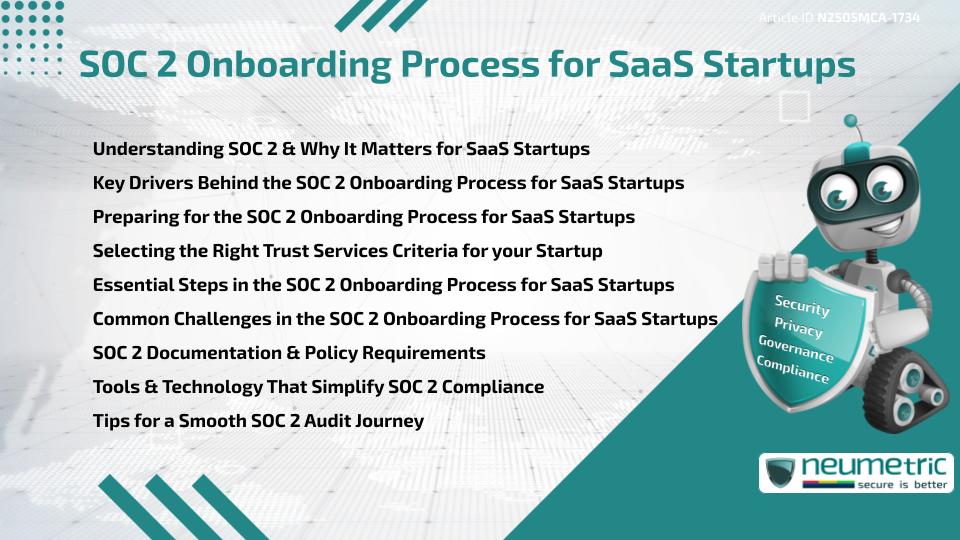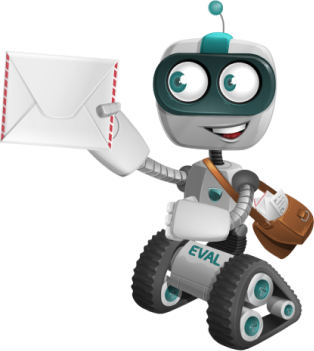Table of Contents
ToggleIntroduction
In today’s rapidly evolving SaaS landscape, earning Customer Trust is essential. 1. A reliable way to show a serious dedication to Data Security is by attaining SOC 2 Compliance. However, the journey toward Compliance begins with a clearly defined SOC 2 onboarding process for SaaS startups. This article explores each phase of onboarding, explains common challenges & provides actionable strategies to support early-stage companies aiming for Audit readiness.
Understanding SOC 2 & Why It Matters for SaaS Startups
SOC 2 or System & Organisation Controls 2, is a Framework developed by the American Institute of Certified Public Accountants [AICPA]. It evaluates how effectively an organisation manages Customer Data based on five Trust Services Criteria: Security, Availability, Processing Integrity, Confidentiality & Privacy.
For SaaS startups, achieving SOC 2 Compliance is not just a badge of credibility—it is often a requirement for working with enterprise clients. The SOC 2 onboarding process for SaaS startups helps set the foundation for operational maturity & trustworthiness.
Read more about AICPA’s SOC 2 Framework here.
Key Drivers Behind the SOC 2 Onboarding Process for SaaS Startups
Several factors influence a startup’s decision to initiate the SOC 2 onboarding process:
- Customer Expectations: Larger clients expect security Certifications before sharing Sensitive Data.
- Market Differentiation: SOC 2 allows startups to distinguish themselves in a crowded & competitive industry.
- Investor Confidence: Demonstrates sound Governance practices to VCs & Stakeholders.
- Operational Scalability: Sets up structured processes from the beginning.
Understanding these drivers helps teams align their Compliance efforts with broader business goals.
Preparing for the SOC 2 Onboarding Process for SaaS Startups
Before diving into implementation, preparation is essential. This involves:
- Conducting a gap assessment
- Defining the project scope (Type I or Type II Audit)
- Identifying the Trust Services Criteria relevant to your operations
- Creating a realistic timeline
- Assigning internal responsibilities
A readiness checklist acts as a guide to make sure nothing critical is overlooked.
Selecting the Right Trust Services Criteria for your Startup
Not all five Trust Services Criteria may apply. Most startups begin with Security as the primary focus & then expand to other criteria based on Customer demands & Risk exposure.
- Security: Mandatory for all SOC 2 reports
- Availability: Useful for platforms promising uptime
- Processing Integrity: Relevant for platforms where data processing accuracy matters
- Confidentiality: Needed for handling sensitive Client data
- Privacy: Critical when storing Personally Identifiable Information [PII]
Essential Steps in the SOC 2 Onboarding Process for SaaS Startups
A structured approach to onboarding includes the following steps:
- Initiate a Gap Assessment: Evaluate where controls are missing.
- Define Control Objectives: Based on your selected Trust Services Criteria.
- Implement Controls & Policies: Include Access Control, change management & vendor Risk Management.
- Automate Where Possible: Use tools for Continuous Monitoring & Evidence Collection.
- Perform Internal Testing: Validate control effectiveness before the Audit.
- Engage an Auditor: Choose a licensed CPA firm experienced in SaaS.
- Undergo the Audit: Complete Type I (design of controls) or Type II (design + operational effectiveness).
Common Challenges in the SOC 2 Onboarding Process for SaaS Startups
Despite best intentions, many startups face hurdles such as:
- Lack of internal security expertise
- Inadequate documentation practices
- Delayed implementation due to resource constraints
- Misalignment between product & Compliance goals
These can be addressed by early planning & involving Compliance partners where needed.
SOC 2 Documentation & Policy Requirements
Documentation is a core component of the SOC 2 onboarding process for SaaS startups. Auditors expect clear, up-to-date Policies for:
- Data Encryption
- Access Control
- Vendor management
- Incident Response
- Business Continuity
Templates can accelerate this stage but must be customised for your operations.
Tools & Technology That Simplify SOC 2 Compliance
To streamline the onboarding process, startups often rely on:
- Policy automation platforms: Manage evidence & control status.
- IAM solutions: Enforce secure Access Controls.
- Audit trail tools: Log & monitor system changes.
- Security awareness training platforms: Educate teams on Best Practices.
These tools reduce manual errors & accelerate Audit readiness.
Tips for a Smooth SOC 2 Audit Journey
- Start small: Focus on core controls before expanding.
- Keep evidence organised & Audit-ready at all times.
- Schedule regular internal reviews.
- Maintain a Risk register to document evolving Threats.
- Foster a security-first culture from day one.
Takeaways
- The SOC 2 onboarding process for SaaS startups is key to building trust with clients & partners.
- Startups should begin with a focused scope & expand as needed.
- Clear documentation, strong internal controls & use of automation tools simplify Compliance.
- Planning & ownership are critical to avoid delays or missteps.
FAQ
What is the purpose of the SOC 2 onboarding process for SaaS startups?
It ensures startups adopt the necessary security practices & internal controls to meet SOC 2 requirements & build trust with clients.
How long does the SOC 2 onboarding process for SaaS startups typically take?
Depending on the complexity & team size, it can take between three (3) to six (6) months for full readiness & Audit completion.
Is it necessary to implement all five Trust Services Criteria during onboarding?
No. Most startups begin with Security & select others based on Client needs & data sensitivity.
Can small teams handle the SOC 2 onboarding process internally?
Yes, but it may be time-consuming. Leveraging tools or outsourcing parts of the process helps reduce the burden.
What is the difference between Type I & Type II audits in the SOC 2 onboarding process for SaaS startups?
Type I checks control design at a single point, while Type II assesses both design & effectiveness over time.
Do all SaaS startups need SOC 2 Compliance?
Not legally, but it is often required by enterprise customers or partners for contract eligibility.
What documents are essential during the SOC 2 onboarding process for SaaS startups?
Policies for access, Incident Response, Risk Management, Security training & Third Party vendors are typically required.
Are there any free resources for SOC 2 onboarding process guidance?
Yes. Many trusted Cybersecurity firms & auditors provide free checklists & policy templates online.
Need help?
Neumetric provides organisations the necessary help to achieve their Cybersecurity, Compliance, Governance, Privacy, Certifications & Pentesting goals.
Organisations & Businesses, specifically those which provide SaaS & AI Solutions, usually need a Cybersecurity Partner for meeting & maintaining the ongoing Security & Privacy needs & requirements of their Clients & Customers.
SOC 2, ISO 27001, ISO 42001, NIST, HIPAA, HECVAT, EU GDPR are some of the Frameworks that are served by Fusion – a centralised, automated, AI-enabled SaaS Solution created & managed by Neumetric.
Reach out to us!


